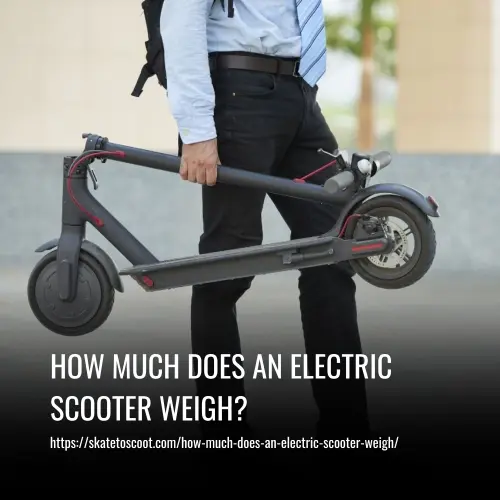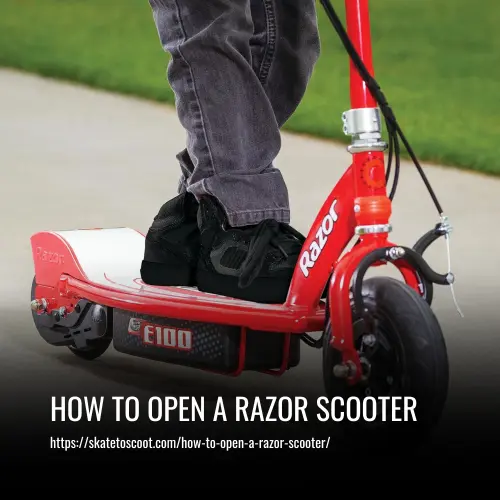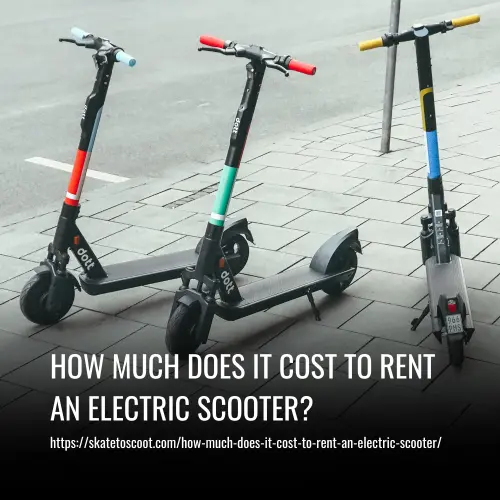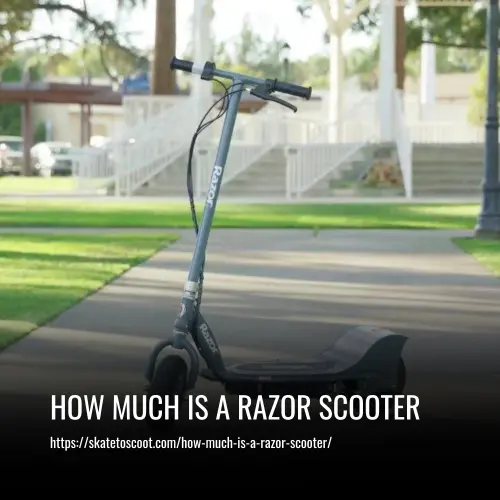As an Amazon Associate we earn from qualifying purchases.
The weight of an electric scooter can vary depending on factors such as battery size, motor power, and build quality. In general, electric scooters range from 15 to 50 pounds. Commuter scooters typically weigh between 15 to 35 pounds, while off-road or all-terrain scooters can weigh around 35 to 50 pounds.
Heavy-duty or high-performance models may weigh up to 100 pounds due to their powerful motors and larger batteries. Whether you prefer a lightweight scooter for easy portability or a heavy-duty one for handling more weight, knowing the different types and their weights is essential.

Types Of Electric Scooter & Their Weight
When it comes to electric scooters, weight plays a crucial role in determining their performance and practicality. In this article, we will explore the three main types of electric scooters and their respective weights.
1. Kick Scooters
Kick scooters are the lightest type of electric scooters and are primarily designed for children. These scooters have an average weight of less than 9 kg, making them easy for kids to carry. However, due to their lightweight construction, kick scooters are not suitable for commuting or heavy-duty use. They lack the power and range required for city commuting and are not designed to handle steep hills.
2. Commuter Scooters
Commuter scooters are the most popular type of electric scooter used by individuals for their everyday commute. These scooters typically weigh between 15 kg to 25 kg, depending on the brand and model. They offer a balance between weight and performance, providing an impressive range of about 15 km to above 30 km. Some high-end brands offer even greater range, such as the Äike T, which boasts up to 40 km range and a remarkable top speed of 25 km/h.
3. Heavy-Duty Scooters
For those seeking a robust and powerful electric scooter, heavy-duty scooters are the ideal choice. These scooters are designed for touring or off-road purposes and are known for their sturdiness and durability. Heavy-duty scooters are significantly bulkier than kick and commuter scooters, with weights ranging from 40 kg to 60 kg and even higher. They feature powerful motors, larger battery capacities, and sturdier frames, enabling them to tackle all kinds of terrains with ease.
Factors Affecting The Weight Of An Electric Scooter
When considering the weight of an electric scooter, there are several factors to keep in mind. These factors include the material used for the frame, the size of the scooter, the battery type and size, and any additional features.
1. Material Used For The Frame
The choice of material for the frame greatly impacts the weight of the electric scooter. Most scooters are made from lightweight and durable materials such as aviation-grade aluminum alloy or carbon fiber. The material not only affects the weight but also the strength and rigidity of the frame.
2. Size Of The Scooter
The size of the electric scooter can significantly impact both its portability and performance. Electric scooters come in various sizes, ranging from lightweight models weighing around 15.4 lbs / 7 kg to heavier models weighing around 155 lbs / 70 kg. Lighter scooters are more portable and energy-efficient but may sacrifice stability and durability, while heavier scooters offer better stability and durability but are less portable and energy-efficient.
3. Motor
The motor is another component that can affect the weight of an electric scooter. Motors with gears tend to be heavier than normal electric motors. The weight of the motor typically ranges between 4 to 6 pounds and may increase if there are front and rear motors in the scooter.
4. Battery Type And Size
The battery type and size play a crucial role in determining the weight of an electric scooter. Larger batteries generally result in a heavier scooter but provide more power and a longer range. Choosing the appropriate battery size and capacity depends on your usage habits and the distance you need to cover.
5. Maximum Load Capacity
The maximum load capacity of an electric scooter refers to the weight limit that it can hold without compromising safety or performance. Different models have varying load capacities, depending on their design and construction materials. It is essential to choose an electric scooter with a load capacity that meets your needs while staying within your desired weight range.
6. Additional Features
Additional features, such as seats, storage compartments, or extra batteries, can increase the weight of an electric scooter. More powerful motors and larger battery capacities also add bulk to the scooter. Consider the benefits of these added features against their impact on the overall weight when choosing your ideal electric scooter.
Why Is the Weight of an E-scooter Important
When it comes to electric scooters, the weight of the scooter is just as important as its size. The weight not only affects the scooter’s performance but also its safety when being ridden. Here’s why the weight of an electric scooter matters:
1. Safety
The weight of the scooter plays a vital role in ensuring rider safety. If a scooter is too light or too heavy for the rider, it can affect their control over the vehicle and overall riding experience. Balance and stability are crucial for a safe ride, and the right weight ensures that riders can control their scooter confidently.
2. Portability
Transporting your scooter may require lifting or carrying it at some point. If the scooter is too heavy for you, it can be challenging to lift or carry, making it inconvenient if it breaks down or needs to be moved quickly. A lighter scooter is more portable and easier to handle.
3. Storage Space
Generally, heavier electric scooters tend to be larger in size. If you live in a space-constrained apartment, storing a bulky scooter can become problematic. Choosing a scooter that is lighter in weight can save you storage space and make it easier to keep your scooter indoors.
4. Speed
Heavy electric scooters tend to have more powerful motors, enabling them to reach higher speeds. While this can be exhilarating for experienced riders, it can also increase the risk of accidents if not handled properly. It is important to match the scooter’s weight and speed capabilities to your riding skills.
Below are some scooter models, showing their mass, speed, and range:
| Brand | Weight | Max. Speed | Range |
| Ninebot Kickscooter D38E | 16.3 kg | 25 km/h | 38 km |
| Razor E300 | 19.5 kg | 24 km/h | 16 km |
| Unagi Model One E500 | 12 kg | 20 km/h (eco-mode) | 25 km |
| Äike T | 19 kg | 25 km/h | 40 km |
| Dualtron X2 Up | 66 kg | 25 km/h (out of box) 110 km/hr (private terrains) |
Should You Pick a Light or Heavy Scooter
When it comes to choosing between a light or heavy electric scooter, your decision should be based on the intended use of the scooter. For kids, lightweight models are a better option as they are easier to navigate and move around without assistance. However, if you are buying a scooter for personal use, opting for an average lightweight model like the Äike T is recommended.
While lightweight scooters may lack the speed and range of heavier models, the Äike T overcomes these challenges. It strikes a balance between weight and performance, offering impressive speed and range without compromising safety. It’s important to note that for safety and regulatory reasons, it’s not advisable to exceed the max speed of 25 km/h of the Äike T.
Advantages And Disadvantages of Heavy-Duty E-scooters
Heavy-duty electric scooters offer some distinct advantages over their lighter counterparts but also come with their fair share of disadvantages. Let’s take a closer look at both sides of the coin.
Advantages of Heavy-Duty E-scooters
1. Incredible speed: Heavy-duty e-scooters typically come equipped with powerful motors that can provide impressive acceleration and top speeds, making them ideal for those who crave a thrilling ride.
2. Can handle tough terrain: With sturdy frames and robust components, heavy-duty scooters are designed to handle rough roads and challenging terrains. Whether it’s uneven pavements or gravel paths, these scooters can take on the challenge with ease.
3. Highly sturdy and stable: The heavy build of these scooters provides increased stability, making them more reliable and safe to ride. This makes them suitable for riders who prefer a more secure and confident riding experience.
Disadvantages of Heavy-Duty E-scooters
1. Very heavy: One of the most significant downsides of heavy-duty e-scooters is their weight. These scooters often weigh a lot more than their lighter counterparts, making them less portable and challenging to maneuver.
2. Not portable: Due to their heavy weight, heavy-duty scooters are not as portable or convenient for transportation as lighter models. They can be harder to carry upstairs or onto public transportation.
3. Expensive: Heavy-duty scooters with powerful motors and advanced features tend to have a higher price tag. This can make them less accessible for budget-conscious individuals or those looking for a more affordable option.
Advantages and Disadvantages of Heavy-Duty Electric Scooter
| Advantages | Disadvantages |
| Electric scooters that are heavy in weight are considered more stable because they use a larger tire than normal | The main disadvantage of these types is the difficulty of carrying and moving them |
| A heavier electric scooter supports the weight of a heavier rider | High price due to the more features and capabilities of this type of electric scooter |
| These types of electric scooters are mostly with front and rear motors, which increase the maximum speed | Maneuvering is somewhat difficult due to the extra weight, which can make maneuvering the scooter relatively difficult |
| The materials used in manufacturing these types of electric scooters are of high quality, which makes them give you a longer life span | High battery consumption due to the heavier weight and the presence of two motors |
Advantages And Disadvantages of Lightweight E-scooters
Lightweight electric scooters offer several advantages and disadvantages compared to their heavier counterparts. Let’s explore the pros and cons of choosing a lighter e-scooter.
Advantages of Lightweight E-scooters
1. Portable: One of the primary advantages of light e-scooters is their portable nature. These scooters are designed to be easy to carry and transport, making them convenient for daily commuting or traveling short distances. They are also easier to store in small spaces.
2. Kid-friendly: Light e-scooters are suitable for younger riders due to their lower weight and smaller frames. They are easier for kids to handle and maneuver, providing a safer and more enjoyable riding experience.
3. Easy to transport: These scooters are typically foldable and compact, making them effortless to transport in cars, on public transportation, or even on a plane. This makes them an excellent choice for individuals who rely on multiple modes of transportation.
Disadvantages of Lightweight E-scooters
1. Not as fast: Light e-scooters often come with less powerful motors, resulting in lower maximum speeds compared to heavy-duty models. If you are looking for a high-speed ride, you may find the lighter scooters underwhelming in terms of acceleration and top speed.
2. Limited range: Due to their smaller battery capacities, lighter e-scooters generally have a shorter range before they need to be recharged. This can be a limitation for longer commutes or for riders who require a scooter with more extended battery life.
Advantages and Disadvantages of Lighter Electric Scooter
| Advantages | Disadvantages |
| Easy to carry and move around | Lightweight electric scooters are less stable than the heavy ones |
| Ease of making maneuvers and sudden movements | In most cases, the light electric scooter is made of aluminum with a small thickness, which makes it unreliable and does not last long (the matter is completely different in the case of carbon fiber). |
| Better performance than the battery because the light weight reduces the motor’s need for electricity | Electric scooters are light in weight and often support the weight of a small rider |
| Its price is fairly cheap | The maximum speed of the light scooter is often low compared to the heavy electric scooter |
FAQs
Electric scooters can vary in weight depending on the model and specifications. Some lightweight models are designed for easy portability, while heavy-duty scooters may be more substantial.
Yes, there are many lightweight electric scooter options available on the market. These scooters are designed to be easily carried and transported, making them ideal for commuters and those needing a portable mode of transportation.
Kick scooters are designed to be lightweight and are primarily intended for kids. Due to their small size and intended audience, they have the least mass among all electric scooters. The average weight of an electric kick scooter is less than 9 kg.
The weight of commuter scooters typically ranges from about 15 kg to 25 kg, depending on the brand and model. Despite their relatively lighter weight, they can provide an impressive range of approximately 15 km to above 30 km. Certain high-end brands, such as the Äike T, can even offer a range of up to 40 km and speeds of up to 25 km/h.
The weight of heavy-duty scooters can range from around 40 kg to 60 kg and even more. These scooters are ideal for touring or off-road purposes, as they possess the power and durability to navigate through various terrains.
The load capacity, or weight limit, of an electric scooter, varies depending on the model. It is important to check the manufacturer’s specifications to ensure that the scooter can safely support your weight.
Some heavy-duty electric scooters have high weight limits, often accommodating riders with a weight capacity of over 300 pounds. These scooters are designed for heavier riders or those needing to carry heavier loads.
The lightest electric scooters are often made from lightweight materials such as aluminum alloy or carbon fibers. These materials contribute to the scooter’s overall weight reduction without compromising durability.
The heaviest electric scooters available can weigh over 100 pounds. These heavy-duty models are typically built to handle rough terrains and carry heavier loads.
The weight of an electric scooter can impact its performance and safety. Lighter scooters are typically more maneuverable and easier to control, while heavier scooters may offer more stability and power.
Heavy-duty electric scooters often come with features such as powerful motors, larger battery capacity for longer range, sturdier frames, hydraulic brakes for added safety, and pneumatic tires for better stability on rough roads.
The weight of the lightest scooter can vary but is generally around 20 to 25 pounds. These lightweight scooters are designed for easy transportation and convenience.
Razor scooters, a popular brand of electric scooters, generally weigh between 20 to 35 pounds. The specific weight will depend on the model and features of the scooter.
Conclusion
In conclusion, the weight of an electric scooter can vary depending on its design, features, and intended use. Lightweight scooters are ideal for easy portability and commuting, weighing around 15 to 30 pounds. These models are often made from materials like aluminum alloy or carbon fiber, offering a balance between performance and weight.
On the other hand, heavy-duty scooters are built for durability and can handle heavier loads but are less portable, weighing between 40 to 100 pounds. They come with features such as larger battery capacity, powerful motors, sturdy frames, hydraulic brakes, and pneumatic tires to handle rough terrains and bike lanes.
It is important to choose an electric scooter that suits your specific needs and preferences, considering factors such as range, motor power, weight capacity, and maneuverability.
Amazon and the Amazon logo are trademarks of Amazon.com, Inc, or its affiliates.



